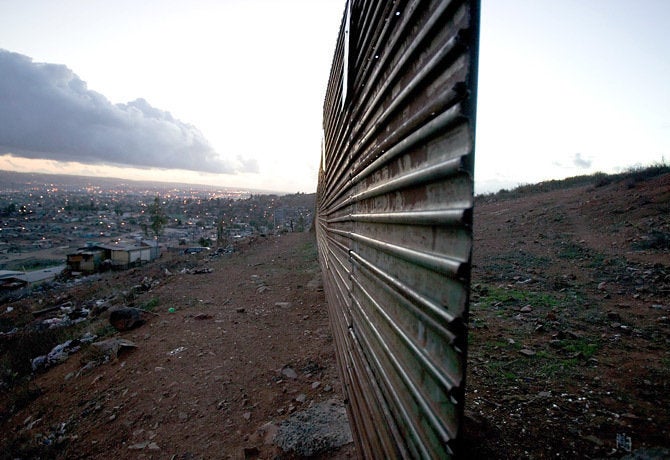
With numbing regularity news bulletins flash regarding groups or individuals suffering severe injuries, snake bites, or dying in the remote deserts or mountains along the 800 mile "Wall" as they attempt to cross the border between Mexico and the USA. In the 24/7 news cycle, this blip quickly fades from our collective memory and we move on to something more interesting, after all, we can't imagine ourselves in the same predicament. Left in the wake are those still living or their relatives, without organized systemic help to search and rescue or recover and claim bodies and try to make arrangements. It doesn't need to be this way and prior to October 1994, it wasn't. Fifteen years of failed immigration policy has not improved the numbers of undocumented aliens entering the country and has cost millions in dollars and human suffering.
International Humanitarian Crisis: Migrant Deaths at the U.S.-Mexico Border
A recent report issued jointly by ACLU and ACLU Foundation of San Diego & Imperial Counties and Mexico's National Commission on Human Rights (CNDH) outlines the disturbing findings in a straight forward manner, along with suggestions on how to reduce the death toll that is only increasing in scale.
"The current policies in place on both sides of the U.S.-Mexico border have created a humanitarian crisis that has led to the deaths of more than 5,000 people," said Kevin Keenan, Executive Director of the ACLU of San Diego and Imperial Counties. "Because of deadly practices and policies like Operation Gatekeeper, the death toll continues to rise unabated despite the decrease in unauthorized crossings due to economic factors."
Some of the highlights within this report:
--The deaths of unauthorized migrants have been a predictable and inhumane outcome of border security policies on the U.S.-Mexico border over the last fifteen years.
Beginning in 1994, the U.S. government implemented a border enforcement policy known as "Operation Gatekeeper" that used a "prevention and deterrence" strategy. The strategy concentrated border agents and resources along populated areas, intentionally forcing undocumented immigrants to extreme environments and natural barriers that the government anticipated would increase the likelihood of injury and death. The stated goal was to deter migrants from crossing.
--Over the last fifteen years, national security concerns have reinforced the deterrence strategy without any improvements in the results. The mutual interest of intercepting national security threats on a shared border reshaped the bilateral relationship between Mexico and the United States, redefining priorities given to immigration and border policies. The national security lens favored the militarization of the border at the cost of migrant lives. In the last five years, the border enforcement budget expanded from $6 billion to $10.1 billion, the number of agents jumped to 20,000; 630 miles of new fencing was completed around urban areas; 300 miles of vehicle barriers were erected; a "virtual fence" of technological infrastructure was installed...and more migrants are dying now than ever before.
Recommendations to reduce migrant deaths are listed in the report:
October 1, 2009 marks the fifteenth anniversary of the launch of Operation Gatekeeper and the ensuing border enforcement policies that have led to the deaths of more than 5,000 people. Prior to Operation Gatekeeper, migrant deaths were few and far between. In its conclusion, the report reflects on the findings and suggests courses of action that the U.S. and Mexican governments could take to protect and advance the human right to life of international migrants.
Action on Day One:
• Recognize border crossing deaths as an international humanitarian crisis.
Action within 100 days:
•Shift more U.S. Border Patrol resources to search and rescue.
•Direct government agencies to allow humanitarian organizations to do their work to save lives and recover remains.
•Establish a binational, one-stop resource for rescue and recovery calls.
•Convene all data collecting agencies to develop a uniform system.
•Commit to transparency.
•Elevate border deaths to a bilateral priority.
•Invite international involvement.
Action within One Year:
•Adopt sensible, humane immigration and border policies.
•Support nongovernmental humanitarian efforts at the border to do what governments are unable or unwilling to do.
These recommendations complement those made in 2002 by the U.S. Commission on Civil Rights to reduce deaths at the border. These included:
1.Demilitarize the border;
2.Establish a guest-worker program;
3.Increase the number of permanent resident visas available to Mexicans;
4.Legalize undocumented immigrants already in the United States;
5.Modify immigration laws that deport immigrants for minor criminal offenses;
6.Encourage cooperation with Mexico;
7.Protect the rights of asylum seekers; and
8.Recognize U.S. citizenship of the Tohono O'odham.
Except for the growing cooperation between Mexico and the United States, the rest of the
solutions have not been considered or adopted.
